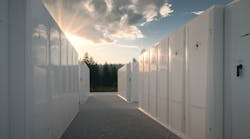Biden Administration Launches Bipartisan Infrastructure Law’s US$505 Million Initiative
The Biden Administration, through the U.S. Department of Energy (DOE), has issued a Request for Information (RFI) seeking public input on the structure of a US$505 million long duration energy storage initiative to increase the availability of and deliver affordable, reliable clean electricity. The new Long Duration Energy Storage for Everyone, Everywhere Initiative, created by President Biden’s Bipartisan Infrastructure Law, will advance energy storage systems toward widespread commercial deployment by lowering the costs and increasing the duration of energy storage resources. Cheaper, longer energy storage can increase local control of the power system, build resilience for communities, minimize power grid disruptions, and help reach President Biden’s goal of 100% clean electricity by 2035.
“The ability to move cheaper, cleaner electricity where and when it is needed most is the linchpin to a reliable energy grid and critical to meeting President Biden’s clean energy goals,” said U.S. Secretary of Energy Jennifer M. Granholm. “The Long Duration Energy Storage for Everyone, Everywhere initiative leverages the expertise of the Department, National Labs, and industry to drive next-generation energy storage — making solar power available when the sun isn’t shining and keeping wind energy on tap when there’s no breeze.”
Shorter duration storage is currently being installed to support today’s increasing amount of renewable energy generation and electrification. With help from the historic investments from President Biden’s Bipartisan Infrastructure Law, more renewables will be deployed on the grid and building and vehicle electrification will continue to rise. Longer duration storage technologies are needed as the nation must increase access and availability of renewable energy sources. Long duration energy storage — defined as systems that can store energy for more than 10 hours at a time — would support a low-cost, reliable, carbon-free electric grid. Cheaper and more efficient storage will make it easier to capture and store clean energy for use when energy generation is unavailable or lower than demand.
The initiative, administered through DOE's new Office of Clean Energy Demonstrations, will work to overcome these challenges and achieve the cost goal by investing approximately US$ 505 million over four years to validate grid-scale long duration energy storage technologies and enhance the capabilities of customers and communities to integrate grid storage more effectively. DOE will implement three energy storage demonstration programs:
- Demonstration: The Demo program will prepare a cohort of promising technologies for utility-scale demonstration, which might not otherwise proceed given potential technology investment risks, through lab, behind-the-meter, or campus demonstrations. Specifically, these field demonstrations are intended at the scale of 100 kW or less and have already been proven at lab-scale.
- Validation: The Demo Projects will enable first-of-a-kind technologies at utility scale by mitigating risk during the final technical validation point before wider deployment, the steepest portion of the commercialization curve. Large long duration storage demonstrations in this program will need to be able to provide at least 10 hours of rated power and undergo enough third-party testing/validation to substantiate a pathway to meeting the target of a levelized cost of storage of US$ 0.05/kWh.
- Piloting: The Pilot Grants program will address institutional barriers to technology adoption in the marketplace. Such barriers can be easier to resolve when a technology has been installed, operated, de-risked, and shown to provide benefit to users, communities, or the power system. Few entities have the financial capability to invest in such a pilot. Pilot grants will mitigate this barrier by enabling greater storage investment by eligible entities which include state energy offices, Tribal Nations, higher education, utilities, and energy storage companies.
Under the overall Long Duration Energy Storage Initiative, DOE is also collaborating with the U.S. Department of Defense for long duration storage demonstrations on government facilities.
DOE’s Ongoing Commitment to Long Duration Energy Storage
DOE’s Long Duration Storage Shot, launched in July 2021, sets a target of achieving a levelized cost of energy storage of US$ 0.05/kWh, a 90% reduction from a 2020 baseline costs by 2030. This cost reduction will make dispatchable clean energy available through long duration energy storage the most cost-effective choice for electricity customers. To meet this target, a wide range of energy storage technologies, including electrochemical, mechanical, thermal, flexible generation, flexible buildings, and power electronics, will need to be considered, well beyond the traditional lithium-ion batteries.
In March, DOE’s Energy Storage for Social Equity Initiative selected 14 communities to receive technical assistance to leverage energy storage as a means of increasing resilience and long-term affordability.
These programs will prioritize projects that leverage a secure domestic supply chain and support the creation of good-paying union jobs. Consistent with the Biden Administration’s Justice40 Initiative, this initiative supports the goal that 40% of the benefits from climate investments flow to disadvantaged communities.
The goal of the RFI is to solicit feedback from a wide range of stakeholders on DOE’s implementation strategy and eligibility requirements. Comments must be received by 5:00 p.m. EDT on June 16, 2022, and can be submitted by emailing [email protected].
A public webinar will be held to provide additional information.


